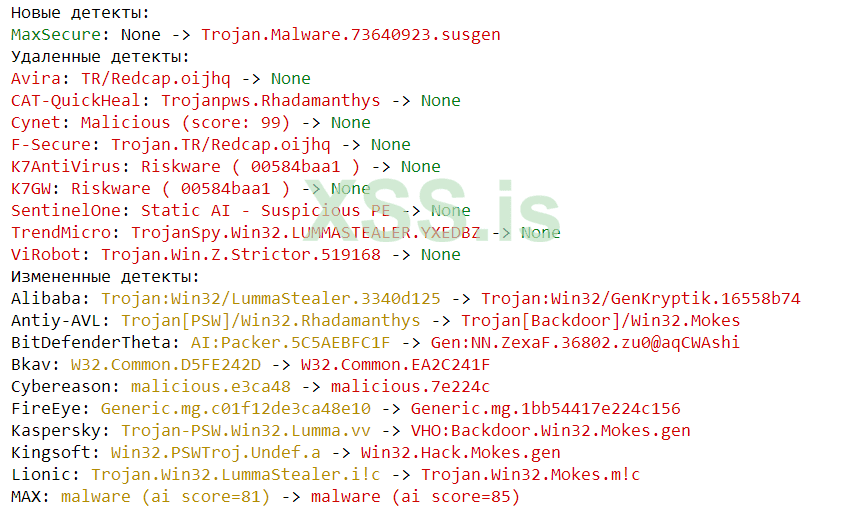D2
Администратор
- Регистрация
- 19 Фев 2025
- Сообщения
- 4,380
- Реакции
- 0
Перед нами увлекательный код на Python, который позволяет получать отчеты о вредоносном ПО от VirusTotal и сравнивать их. Звучит интригующе, не правда ли? Давайте рассмотрим его подробнее.

Код начинается с импорта необходимых библиотек, таких как
Спойлер: Импорт библиотек
Python: Скопировать в буфер обмена
Далее определяется класс
Спойлер: Класс VirusTotalAPI
Python: Скопировать в буфер обмена
Следующий класс
Спойлер: Класс ReportManager
Python: Скопировать в буфер обмена
Класс
Спойлер: Класс DetectionComparator
Python: Скопировать в буфер обмена
Наконец, класс
Спойлер: Класс DetectionPrinter
Python: Скопировать в буфер обмена
В главной функции
Спойлер: Функция main
Python: Скопировать в буфер обмена
Полный код
Python: Скопировать в буфер обмена
Вот и всё! Теперь вы имеете представление о том, как работает этот код и для чего он предназначен. Не забудьте запустить его и посмотреть на результаты в терминале. Удачи в изучении Python!
Вступление
Код начинается с импорта необходимых библиотек, таких как
requests для работы с HTTP-запросами и colorama для красивого вывода текста в терминале.Спойлер: Импорт библиотек
Python: Скопировать в буфер обмена
Код:
import requests
import json
import os
from colorama import init, Fore, StyleКласс VirusTotalAPI
Далее определяется класс
VirusTotalAPI, который позволяет взаимодействовать с API VirusTotal. Он принимает ваш API-ключ при инициализации и имеет метод download_report для загрузки отчета о файле по его хэш-сумме.Спойлер: Класс VirusTotalAPI
Python: Скопировать в буфер обмена
Код:
class VirusTotalAPI:
def __init__(self, api_key):
self.api_key = api_key
self.base_url = "https://www.virustotal.com/vtapi/v2"
def download_report(self, file_hash):
url = f"{self.base_url}/file/report?apikey={self.api_key}&resource={file_hash}"
response = requests.get(url)
if response.status_code == 200:
return response.json()
else:
print(f"Ошибка при загрузке отчета для хеша {file_hash}")
return NoneКласс ReportManager
Следующий класс
ReportManager упрощает работу с отчетами. Он кэширует отчеты на диск, чтобы не загружать их повторно. Метод get_report проверяет, есть ли отчет в кэше, и если нет, загружает его через VirusTotalAPI.Спойлер: Класс ReportManager
Python: Скопировать в буфер обмена
Код:
class ReportManager:
def __init__(self, api_key):
self.api = VirusTotalAPI(api_key)
def get_report(self, file_hash):
filename = f"C:/temp/{file_hash}.json"
if os.path.exists(filename):
print(f"Отчет для хеша {file_hash} уже существует на диске.")
with open(filename) as f:
return json.load(f)
else:
report = self.api.download_report(file_hash)
if report:
with open(filename, 'w') as f:
json.dump(report, f)
return reportКласс DetectionComparator
Класс
DetectionComparator - настоящая звезда нашего шоу! Он сравнивает два отчета и определяет, какие антивирусные движки обнаружили новые угрозы, какие перестали их обнаруживать, и какие изменили свои результаты. Это помогает отслеживать изменения в детекции вредоносного ПО.Спойлер: Класс DetectionComparator
Python: Скопировать в буфер обмена
Код:
class DetectionComparator:
def compare(self, report1, report2):
new_detections = {}
removed_detections = {}
changed_detections = {}
# Сложная логика сравнения отчетов...Класс DetectionPrinter
Наконец, класс
DetectionPrinter отвечает за красивый вывод результатов сравнения в терминал. Он использует библиотеку colorama для выделения новых, удаленных и измененных детектов разными цветами.Спойлер: Класс DetectionPrinter
Python: Скопировать в буфер обмена
Код:
class DetectionPrinter:
def print_detections(self, new_detections, removed_detections, changed_detections):
if new_detections:
print("Новые детекты:")
for engine, results in new_detections.items():
print(
f"{Fore.GREEN}{engine}{Style.RESET_ALL}: {results['old_result']} -> {Fore.RED}{results['new_result']}{Style.RESET_ALL}")
# Вывод удаленных и измененных детектов...Основная функция
В главной функции
main происходит инициализация классов, загрузка отчетов и вызов сравнения и вывода результатов. Вы можете изменить хэш-суммы файлов для тестирования или использовать свой API-ключ VirusTotal.Спойлер: Функция main
Python: Скопировать в буфер обмена
Код:
def main():
api_key = "" # Ваш API-ключ VirusTotal
hash1 = "2593f6685eb741cac83c2529e5d69fda18a82007e1c4fc721bfa6c286c678db2"
hash2 = "cc6ed492e33761a111a2717823f5f1f6de9365aa22e042364eadefe16c1024a8"
# Создание директории для кэширования отчетов
if not os.path.exists(r"C:\temp"):
os.makedirs(r"C:\temp")
report_manager = ReportManager(api_key)
report1 = report_manager.get_report(hash1)
report2 = report_manager.get_report(hash2)
if report1 and report2:
comparator = DetectionComparator()
new_detections, removed_detections, changed_detections = comparator.compare(report1, report2)
printer = DetectionPrinter()
printer.print_detections(new_detections, removed_detections, changed_detections)Полный код
Python: Скопировать в буфер обмена
Код:
import requests
import json
import os
from colorama import init, Fore, Style
init() # Инициализация colorama
class VirusTotalAPI:
def __init__(self, api_key):
self.api_key = api_key
self.base_url = "https://www.virustotal.com/vtapi/v2"
def download_report(self, file_hash):
url = f"{self.base_url}/file/report?apikey={self.api_key}&resource={file_hash}"
response = requests.get(url)
if response.status_code == 200:
return response.json()
else:
print(f"Ошибка при загрузке отчета для хеша {file_hash}")
return None
class ReportManager:
def __init__(self, api_key):
self.api = VirusTotalAPI(api_key)
def get_report(self, file_hash):
filename = f"C:/temp/{file_hash}.json"
if os.path.exists(filename):
print(f"Отчет для хеша {file_hash} уже существует на диске.")
with open(filename) as f:
return json.load(f)
else:
report = self.api.download_report(file_hash)
if report:
with open(filename, 'w') as f:
json.dump(report, f)
return report
class DetectionComparator:
def compare(self, report1, report2):
new_detections = {}
removed_detections = {}
changed_detections = {}
for engine, result in report2['scans'].items():
if engine in report1['scans']:
if result['detected'] != report1['scans'][engine]['detected']:
if result['detected']:
new_detections[engine] = {
'old_result': report1['scans'][engine]['result'],
'new_result': result['result']
}
else:
removed_detections[engine] = {
'old_result': report1['scans'][engine]['result'],
'new_result': result['result']
}
elif result['detected'] and result['result'] != report1['scans'][engine]['result']:
changed_detections[engine] = {
'old_result': report1['scans'][engine]['result'],
'new_result': result['result']
}
else:
if result['detected']:
new_detections[engine] = {
'old_result': None,
'new_result': result['result']
}
for engine, result in report1['scans'].items():
if engine not in report2['scans']:
if result['detected']:
removed_detections[engine] = {
'old_result': result['result'],
'new_result': None
}
return new_detections, removed_detections, changed_detections
class DetectionPrinter:
def print_detections(self, new_detections, removed_detections, changed_detections):
if new_detections:
print("Новые детекты:")
for engine, results in new_detections.items():
print(
f"{Fore.GREEN}{engine}{Style.RESET_ALL}: {results['old_result']} -> {Fore.RED}{results['new_result']}{Style.RESET_ALL}")
if removed_detections:
print("Удаленные детекты:")
for engine, results in removed_detections.items():
print(
f"{Fore.RED}{engine}{Style.RESET_ALL}: {Fore.RED}{results['old_result']}{Style.RESET_ALL} -> {Fore.GREEN}{results['new_result']}{Style.RESET_ALL}")
if changed_detections:
print("Измененные детекты:")
for engine, results in changed_detections.items():
print(
f"{engine}: {Fore.YELLOW}{results['old_result']}{Style.RESET_ALL} -> {Fore.RED}{results['new_result']}{Style.RESET_ALL}")
def main():
api_key = ""
hash1 = "2593f6685eb741cac83c2529e5d69fda18a82007e1c4fc721bfa6c286c678db2"
hash2 = "cc6ed492e33761a111a2717823f5f1f6de9365aa22e042364eadefe16c1024a8"
if not os.path.exists(r"C:\temp"):
os.makedirs(r"C:\temp")
report_manager = ReportManager(api_key)
report1 = report_manager.get_report(hash1)
report2 = report_manager.get_report(hash2)
if report1 and report2:
comparator = DetectionComparator()
new_detections, removed_detections, changed_detections = comparator.compare(report1, report2)
printer = DetectionPrinter()
printer.print_detections(new_detections, removed_detections, changed_detections)
if __name__ == "__main__":
main()Вот и всё! Теперь вы имеете представление о том, как работает этот код и для чего он предназначен. Не забудьте запустить его и посмотреть на результаты в терминале. Удачи в изучении Python!